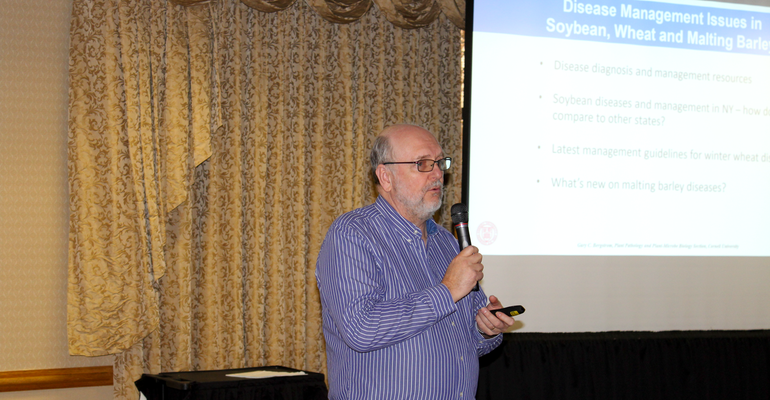February 19, 2019

By Deborah Jeanne Sergeant
Farmers saw a lot of seed decay, downy mildew and purple seed stain in 2018. But not enough to cause major yield issues, according to Gary Bergstrom, plant pathologist at Cornell University.
Still, preventing diseases makes more sense than scrambling to control outbreaks once they've spread.
Speaking at the recent Soybean/Small Grains Congress in Waterloo, N.Y., Bergstrom said farmers should soil test before planting so they know what types of fungicides can best address any potential issues. This involves taking a 15- to 20-inch deep soil sample from various parts of a field, then combining these samples to get a good representation for lab testing.
He said farmers should plan ahead if using soybean cyst nematode-resistant seed to reduce its effects and to rotate with corn.
"You can get 45% to 50% decrease in populations," he said. "Almost all commercial varieties and sources have SCN resistance. It's more prevention than active management at this point."
Soybean cyst nematodes were found on a farm in Cayuga County, but Bergstrom thinks they’re more widespread as they can be difficult to find in a field and observe.
"I think there's a lot we can do to prevent its spread in New York," he said. "In Iowa, they can have a 10% loss without any apparent symptoms above soil. It can sneak up on us in New York."
He encourages farmers to look at the roots of plants for nematode cysts and soil test in late August or early fall.
White mold has also become an issue on farms.
"We're in the ‘white mold club’ and I don't foresee that changing," he said.
Managing this disease goes beyond just selecting a resistant variety, he said. Farmers he's spoken to have found success spraying Aproach, Omega and Endura brands.
"Some require second application," he said.
 PROACTIVE NOT REACTIVE: Gary C. Bergstrom, plant pathologist at Cornell, says farmers should get ahead of soybean cyst nematode, white mold or other issues before they become problems this year.
PROACTIVE NOT REACTIVE: Gary C. Bergstrom, plant pathologist at Cornell, says farmers should get ahead of soybean cyst nematode, white mold or other issues before they become problems this year.

Each brand offers recommendations. Operators should read and follow any fungicide's directions. Some are not permitted in certain counties or near waterways, for example. Farmers should always use them at the concentration and with the equipment stated in the directions for both safety and efficacy.
Managing head blight
Farmers raising small grains saw few issues with fusarium head blight in 2018, according to Bergstrom. He said that an integrated approach — using fusarium-resistant cultivars, the correct fungicide, prediction tools and management practices such as no-till — can help farmers reduce instances of fusarium head blight, also known as scab, better than just using fungicide, although "using fungicide is pretty much a standard thing," he said.
Brands such as Carumba, Prosaro and Tilt can provide good control.
"It's not about using fungicide alone but putting it on in fall for lowering white mold along with using resistant varieties," he said.
When to apply fungicide also makes a big difference. For wheat, the best time is early flowering. That's when yellow anthers appear or stick out from the middle of the wheat spike. Application after five to seven days will still work, he said.
When it comes to closed-flowering spring barley, Bergstrom said to apply once they're at full head sage as the spike has totally emerged above the flag leaf collar. Again, a few days’ delay due to weather — three days to a week — is fine, he said.
Winter barley needs its fungicide at full head stage or up to seven days after.
Foliar diseases showing up
Bergstrom said that foliar diseases that are now widespread in other states don't simply appear overnight.
"They can sneak up on you," he said, "like mildew, rust, leaf spot and glume blotch. We've seen increases in stripe rust. That needs to be a part of our variety selection."
He recommends signing up at scabusa.org/fhb_alert.php to receive alerts and updates on fusarium head blight from the U.S. Wheat and Barley Scab Initiative.
Farmers can learn more by going to the Crop Protection Network, a multistate and international organization that provides information from academic researchers and others to help farmers.
Sergeant writes from central New York.
You May Also Like




